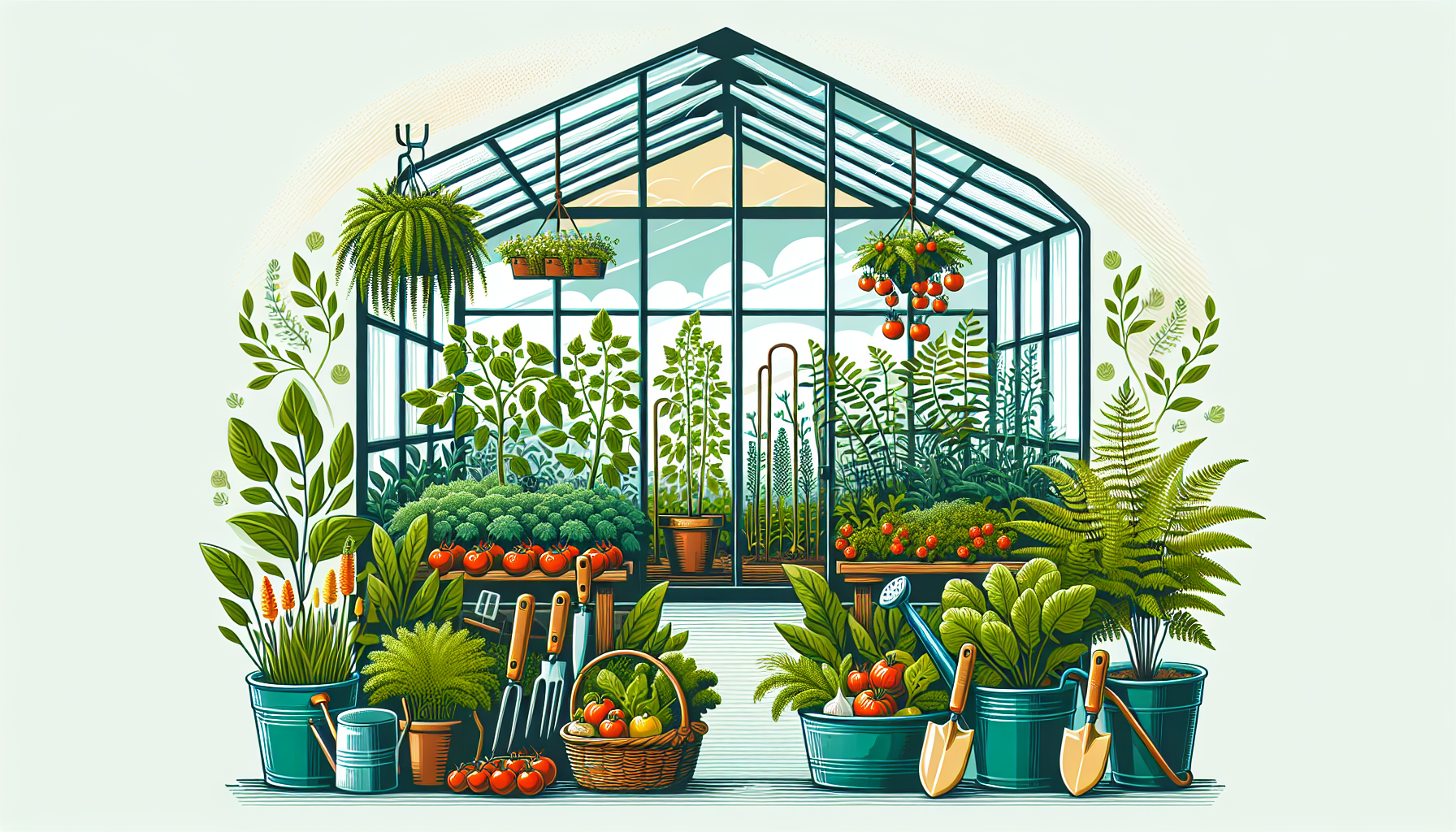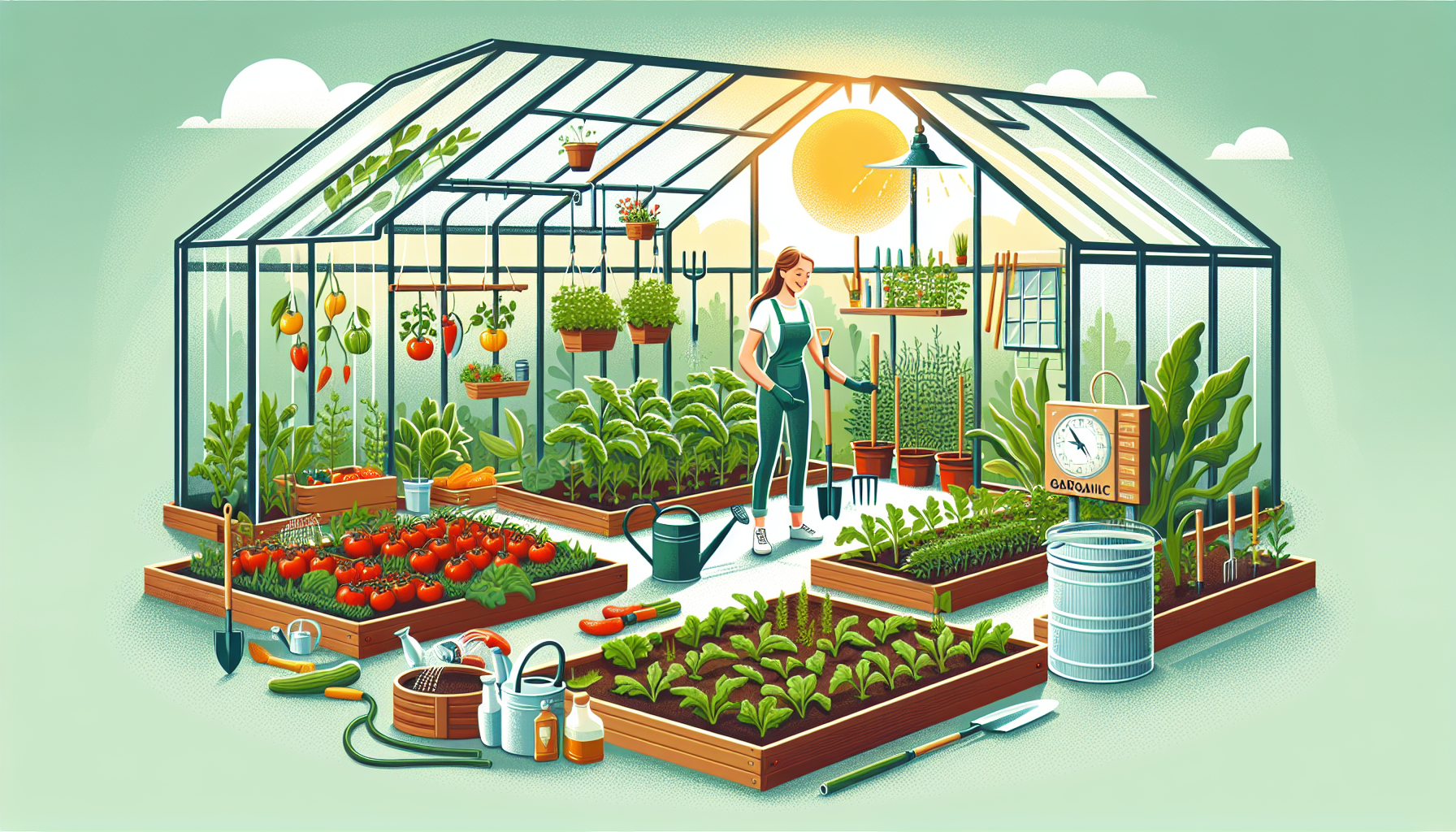
Are you looking to transform your greenhouse into an organic growing powerhouse? Look no further, because “A Guide to Organic Gardening in a Greenhouse” has everything you need. Cultivating a thriving garden, filled with healthy, robust plants, doesn’t have to be an uphill battle. With this comprehensive guide at your fingertips, you’ll gain in-depth knowledge about viable techniques for organic gardening, setting up the ideal greenhouse conditions, and best practices for plant health and maximum yield. Ready to embark on this green-thumb adventure of year-round growing? Let’s ignite that passion and help you create your very own botanical paradise.

Understanding Organic Gardening in a Greenhouse
Organic gardening, as you might be aware, focuses on growing plants in a way that’s in harmony with nature, rather than trying to overpower it. The main idea is to cultivate plants without the use of any synthetic fertilizers, pesticides or genetically modified organisms. This style of gardening respects the biodiversity and sustainability whilst promoting a healthy diet and lifestyle.
In the context of a greenhouse, organic gardening enables you to extend the growing season for your plants by creating an environment in which they can thrive. Greenhouses let you control various factors affecting your plants’ growth, like temperature and humidity, making it a lot easier to cultivate a variety of plants all year round.
Definition and Principles of Organic Gardening
Organic gardening, in its simplest terms, means gardening without the use of synthetic inputs like fertilizers or pesticides, but more than that, it is a holistic approach towards plant care and cultivation. Organic gardening principles do not just stop at eliminating synthetic products, they emphasize improving the soil health, maintaining biodiversity, and protecting natural habitats. The overarching goal is to sustain and enhance the health of the ecosystem.
Benefits of a Greenhouse for Organic Cultivation
There’s something inherently rewarding about growing your own food, but when you manage to do so organically and in the controlled environment of a greenhouse, the benefits multiply. Greenhouses moderate the climate, ensuring your plants are protected from harsh weather conditions and can grow all year round. They offer an isolated environment that can be easier to control in terms of pests and diseases. In an organic greenhouse, you can create the ideal conditions for your plants to flourish, without resorting to potentially harmful synthetic inputs.
Similarities and Differences between Outdoor and Greenhouse Organic Gardening
Greenhouse and outdoor gardening share some similarities and differences. Both involve the use of organic methods to nurture plants. However, greenhouse gardening provides a controlled environment where temperature, humidity, and light can be manipulated to the plants advantage. This level of control isn’t generally possible in outdoor gardening. On the downside though, greenhouses require more upfront investment and maintenance than a regular garden patch.
Designing Your Organic Greenhouse
Designing an organic greenhouse requires careful thought and planning to ensure you create an effective and productive space. Here are some factors to consider:
Choosing the Right Location
The ideal location for your greenhouse should receive ample sunlight, have easy access to water and be safe from strong winds or potential flooding. It also needs to be conveniently accessible for you as you’ll be frequenting it quite often!
Selecting the Greenhouse Structure and Materials
Next comes choosing the right structure for your greenhouse. Consider the size, your available budget, and your specific growing needs. Material type is also important. Glass greenhouses tend to last longer and offer greater clarity for sunlight, while polycarbonate or plastic greenhouses offer better insulation and are often less expensive.
Optimizing the Layout for Plant Health and Efficiency
An efficient layout is key to maximizing your greenhouse’s output. Ensure there is enough room for your plants to grow without overcrowding. Also, be sure to leave sufficient access paths for maintenance and harvesting.
Creating an Ideal Greenhouse Environment
The success of an organic greenhouse depends greatly on the environment within it. Here’s what you need to focus on:
Temperature Control and Regulation
Controlling temperature in your greenhouse is crucial as it directly affects plant growth. You’ll need to install a monitoring system to keep track of temperature levels, and equipment such as heaters or cooling fans to control it.
Humidity Management in an Organic Setting
Optimum humidity levels are also crucial for plant health. Too much humidity can invite mold and rot, too little can cause plants to dry out. Ventilation, shading, and misting are some methods that can help maintain appropriate humidity levels.
Ensuring Adequate Ventilation and Airflow
Good ventilation helps control temperature, humidity and prevents the buildup of harmful gases. It also aids in pollination and strengthens the plant structure by subjecting them to gentle air movement.
Soil Management for Organic Greenhouses
Healthy soil equals healthy plants. Therefore, understanding and managing your soil should be a top priority.
Composition and Preparation of Organic Soil
Organic soil, rich in compost and other organic matter, provides nutrients essential for your plants. The soil should ideally be well-drained and slightly acidic to neutral in pH.
Maintaining Soil Health and Nutrient Levels
Regular testing of soil is essential to keeping track of the nutrient levels and pH balance. Adding organic matter, rotating crops and using cover crops can help maintain soil health.
Methods for Soil Sterilization
While you want to keep your soil healthy and active, you also need to manage potentially harmful pests and diseases. Soil sterilization methods like solarization or using organic fungicides can control these threats without harming beneficial soil organisms.

Organic Pest and Disease Control
Pest and disease management is challenging but essential in organic gardening. Here’s how you can tackle this.
Preventive Measures Against Infestations
A strong defense is the best offense. Maintaining a clean environment, planting disease-resistant varieties, and introducing beneficial insects can help prevent pest infestations.
Organic Pesticides and Their Application
When infestations do occur, organic pesticides like neem oil or insecticidal soaps can be useful. Always follow the label instructions for safe usage.
Natural Predators and Biological Control Methods
Beneficial insects and organisms like ladybugs, spiders, and nematodes can be introduced to combat harmful pests. This is known as biological pest control.
Organic Fertilization Techniques
Organic fertilization is about feeding the soil so that it can feed your plants. Here’s how you can do this:
Types of Organic Fertilizers and Their Benefits
Organic fertilizers like animal manures, compost, and bone meal provide essential nutrients to the plants and improve soil structure. They release nutrients slowly and help build up the soil fertility over the long term.
Composting Methods for Greenhouse Fertilizer
Composting recycles organic waste into rich, nutritious compost. It can be done via various methods like traditional pile composting, vermicomposting, or bokashi composting.
Application Schedules and Techniques for Optimal Growth
Fertilizer needs to be applied properly and at the right time to benefit your plants. Usually, it’s best applied at planting time and during key growth stages.
Organic Water Management
Water is life for your plants, and managing it properly is key to a successful organic greenhouse.
Water Conservation Practices
To conserve water, consider practices like mulching, which limits evaporation, and watering in the morning or late evening when the sun is less intense.
Using Rainwater and Recycled Water
Collecting and using rainwater is an excellent way to conserve water. Similarly, you can recycle household water for irrigation, provided it’s free from harmful chemicals.
Drip Irrigation Systems for Organic Gardening
Drip irrigation delivers water directly to the plant roots, reducing evaporation and water wastage. It’s a great watering technique for an organic greenhouse.
Choosing Plants for the Organic Greenhouse
Choosing the right plants for your greenhouse will set you up for success.
Selecting Varieties Suited to Greenhouse Cultivation
These will depend on your climate, but many varieties of vegetables, herbs, flowers, and even fruit can thrive in a greenhouse environment.
Seasonal Planning for Year-Round Production
With a greenhouse, you can plan your planting schedules for a year-round harvest. Use a greenhouse to grow warm season crops during the colder months and vice versa.
Companion Planting and Biodiversity
Companion planting is a method of growing plants that benefit each other close by. Incorporating biodiversity in your greenhouse also helps to deter pests.
Seed Starting and Plant Propagation
Starting your own seeds and propagating plants can be a rewarding part of greenhouse gardening.
Organic Seed Selection and Treatment
Choose organic seeds to ensure your plants start off right. Some seeds might require soaking or scarification before they can germinate.
Techniques for Germinating Seeds Organically
Once your seeds are ready, use seed trays or pots filled with organic compost to start your seeds. Keep them in a warm, sunny spot and keep the compost moist.
Cuttings, Grafting, and Other Propagation Methods
Besides seed starting, techniques like cuttings or grafting can help you produce more plants. Cuttings involve taking a piece of a plant and growing it into a new one, while grafting involves joining two different plants together.
Challenges and Solutions in Organic Greenhouse Gardening
Organic gardening in a greenhouse isn’t without challenges. Here are some issues you might face and how to solve them:
Dealing with Common Organic Greenhouse Issues
Common issues include pests, temperature and humidity fluctuations, and nutrient deficits. Good monitoring and prevention practices can help manage these challenges.
Adaptation Strategies for Climate Change
Climate change is a reality and can have a significant impact on your greenhouse. Building a resilient greenhouse with adaptable systems and plants can help you weather any changes.
Leveraging Technology for Sustainable Organic Solutions
Modern technology can aid in organic gardening. From making compost faster, drip irrigation systems to better pest management, technology provides numerous sustainable solutions for organic greenhouse gardening.
In conclusion, organic gardening in a greenhouse can be a fruitful endeavor with various benefits, both for you and the environment. By understanding and applying the principles meticulously, you can enjoy a bountiful harvest year-round. Happy gardening!

